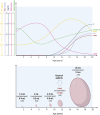Molecular insights into Sertoli cell function: how do metabolic disorders in childhood and adolescence affect spermatogonial fate?
- PMID: 38961093
- PMCID: PMC11222552
- DOI: 10.1038/s41467-024-49765-1
Molecular insights into Sertoli cell function: how do metabolic disorders in childhood and adolescence affect spermatogonial fate?
Abstract
Male infertility is a major public health concern globally with unknown etiology in approximately half of cases. The decline in total sperm count over the past four decades and the parallel increase in childhood obesity may suggest an association between these two conditions. Here, we review the molecular mechanisms through which obesity during childhood and adolescence may impair future testicular function. Several mechanisms occurring in obesity can interfere with the delicate metabolic processes taking place at the testicular level during childhood and adolescence, providing the molecular substrate to hypothesize a causal relationship between childhood obesity and the risk of low sperm counts in adulthood.
© 2024. The Author(s).
Conflict of interest statement
The authors declare no competing interests.
Figures




Similar articles
-
The production of glial cell line-derived neurotrophic factor by human sertoli cells is substantially reduced in sertoli cell-only testes.Hum Reprod. 2017 May 1;32(5):1108-1117. doi: 10.1093/humrep/dex061. Hum Reprod. 2017. PMID: 28369535 Free PMC article.
-
[The sertoli cells, testicular differentiation and male infertility].Akush Ginekol (Sofiia). 2012;51 Suppl 1:15-8. Akush Ginekol (Sofiia). 2012. PMID: 23236673 Review. Bulgarian. No abstract available.
-
Impaired spermatogenesis associated with changes in spatial arrangement of Sertoli and spermatogonial cells following induced diabetes.J Cell Biochem. 2019 Oct;120(10):17312-17325. doi: 10.1002/jcb.28995. Epub 2019 May 20. J Cell Biochem. 2019. PMID: 31111540
-
The emerging role of extracellular vesicles in the testis.Hum Reprod. 2023 Mar 1;38(3):334-351. doi: 10.1093/humrep/dead015. Hum Reprod. 2023. PMID: 36728671
-
Molecular insights into hormone regulation via signaling pathways in Sertoli cells: With discussion on infertility and testicular tumor.Gene. 2020 Aug 30;753:144812. doi: 10.1016/j.gene.2020.144812. Epub 2020 May 26. Gene. 2020. PMID: 32470507 Review.
Cited by
-
[Research progress on glycolipid metabolism of Sertoli cell in the development of spermatogenic cell].Zhejiang Da Xue Xue Bao Yi Xue Ban. 2025 Mar 25;54(2):257-265. doi: 10.3724/zdxbyxb-2024-0346. Zhejiang Da Xue Xue Bao Yi Xue Ban. 2025. PMID: 40065698 Free PMC article. Review. Chinese.
-
Effect of pubertal induction with combined gonadotropin therapy on testes development and spermatogenesis in males with gonadotropin deficiency: a cohort study.Hum Reprod Open. 2025 May 13;2025(2):hoaf026. doi: 10.1093/hropen/hoaf026. eCollection 2025. Hum Reprod Open. 2025. PMID: 40463510 Free PMC article.
-
Effect of lycium barbarum polysaccharide on ameliorating high-fat diet-damaged spermatogenesis via PCSK9 and TLR4 signaling pathways in obese mice.Mol Biol Rep. 2025 Aug 18;52(1):832. doi: 10.1007/s11033-025-10928-y. Mol Biol Rep. 2025. PMID: 40824306 No abstract available.
-
Follicle-Stimulating Hormone and Testosterone Play a Role in the Regulation of Sertoli Cell Functions Following Germ Cell Depletion In Vitro.Int J Mol Sci. 2025 Mar 17;26(6):2702. doi: 10.3390/ijms26062702. Int J Mol Sci. 2025. PMID: 40141344 Free PMC article.
-
Testicular function in postpubertal patients with growth hormone deficiency: A prospective controlled study.J Clin Transl Endocrinol. 2025 Jan 15;39:100383. doi: 10.1016/j.jcte.2025.100383. eCollection 2025 Mar. J Clin Transl Endocrinol. 2025. PMID: 39897110 Free PMC article.
References
-
- World Health Organization. Obesity and Overweight 2021 (World Health Organization, accessed 16 July 2023); http://www.who.int/mediacentre/factsheets/fs311/en/2021.
-
- Chambers TJ, Richard RA. The impact of obesity on male fertility. Hormones (Athens) 2015;14:563–568. - PubMed
Publication types
MeSH terms
LinkOut - more resources
Full Text Sources
Miscellaneous

